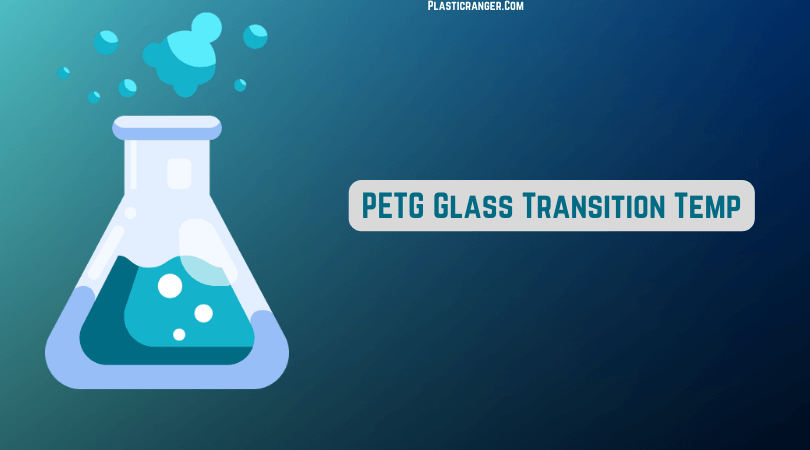PETG Glass Transition Temperature
PETG material is a transparent copolymer and thermoplastic known for its outstanding durability, chemical resistance, and moldability. It is a variation of PET (Polyethylene terephthalate) that has been improved to make it easier to mold into various shapes, thanks to its low-molding temperatures. PETG can also be heat-bent and vacuum-formed.
PETG glass transition temperature is 85°C or 185°f.
This implies that when the plastic is kept below its glass transition temperature, it appears rigid with a smooth, glass-like texture. However, when it is heated above this critical temperature, it becomes more pliable and takes on a rubber-like texture.
What is Glass Transition Temperature?
The glass transition temperature (Tg) is the temperature at which a substance changes from a rigid, solid, glass-like state to a more flexible, rubbery state due to an increase in the molecular mobility of its components.
When the temperature goes above Tg, the molecules in the substance can move more freely, causing it to exhibit a viscous flow. Conversely, the substance becomes brittle when the temperature is below Tg and behaves elastically.
How is Tg of PETG Calculated?
The most commonly used technique for determining the glass transition temperature (Tg) of plastics, including PETG, is ASTM E1356. This method utilizes either differential thermal analysis (DTA) or differential scanning calorimetry (DSC) to evaluate the Tg of materials.
However, it’s worth noting that these techniques are only suitable for amorphous materials or crystalline substances that have stable partial amorphous areas and don’t undergo decomposition in the glass transition region.
DTA and DSC involve applying thermal input to a sample to trigger peaks corresponding to endothermic and exothermic transitions, indicating phase changes. DTA measures the temperature or time difference between the sample and reference materials while monitoring the temperature changes of the sample in a specific atmosphere.
In contrast, DSC measures the difference in heat flow to a sample and reference material while monitoring the programmed temperature changes in a specific atmosphere.
Besides the DTA and DSC methods, other techniques are available to determine the glass transition temperature of ABS plastic. These techniques include
- Thermomechanical analysis
- Thermal expansion measurement
- Micro-heat transfer measurement
- Heat capacity
- Isothermal compressibility,
- Specific heat measurements.
How PETG Tg Affects its Other Properties
PETG glass transition temperature significantly impacts its melting point and mechanical, thermal, physical, and chemical properties.
Melting Point
PETG melting point is influenced by its glass transition temperature. Above the Tg, PETG becomes soft and pliable, which can reduce its melting point. Conversely, PETG is hard and brittle below the Tg, which can increase its melting point.
Mechanical Properties
PETG’s mechanical properties are influenced by its Tg, particularly its stiffness and toughness. Below the Tg, PETG is rigid and brittle, while above the Tg, PETG becomes more flexible and impact-resistant.
Physical Properties
PETG’s physical properties, such as transparency, density, and color, are not significantly affected by its Tg.
Thermal Properties
PETG’s thermal properties are impacted by its Tg as well. When PETG is heated above its Tg, it has a lower heat deflection temperature, which can cause it to deform under high temperatures.
Conversely, when PETG is cooled below its Tg, it has a higher heat deflection temperature, which enables it to endure high temperatures without deformation.
Chemical Properties
PETG’s chemical properties are affected by its Tg as well. Above the Tg, PETG is more susceptible to chemical attack and can degrade more quickly in the presence of certain chemicals.
On the other hand, below the Tg, PETG is more resistant to chemical attacks and can withstand exposure to various chemicals.
Factors Affecting PETG Glass Transition Temperature
Several factors, including molecular weight, the presence of additives, and processing conditions, can influence the glass transition temperature of PETG.
Molecular Weight
The glass transition temperature of PETG is influenced by its molecular weight, which alters the spacing between the molecular chains. The distance between the chains increases when the molecular weight increases, resulting in a higher glass transition temperature. Conversely, a lower molecular weight reduces the distance between the chains, leading to a lower glass transition temperature.
Additives
The presence of additives can also affect the glass transition temperature of PETG. For example, adding plasticizers can lower the Tg of PETG by increasing the free volume between the molecular chains. On the other hand, adding fillers such as glass fibers or carbon black can improve the Tg by increasing the strength of the molecular chains.
Processing Conditions
PETG glass transition temp can also be affected by the processing conditions during its manufacture. For instance, high-temperature annealing can increase its Tg by reorganizing the molecular chains into a more structured state. Conversely, quenching PETG at low temperatures can reduce its Tg by freezing the molecular chains into a more chaotic state.
The Conclusion
In conclusion, the glass transition temperature is a critical characteristic of PETG that affects its behavior and performance in various applications. Manufacturers can optimize their products’ design and implementation by understanding the factors influencing PETG’s glass transition temperature.
Furthermore, using appropriate techniques to measure the glass transition temperature of PETG is crucial for ensuring the material’s suitability for specific temperature ranges. Ultimately, a better understanding of PETG’s glass transition temperature can enhance the material’s usability in numerous industries, from packaging to 3D printing.
Thanks for reading. Have a wonderful day.
Quick Navigation

